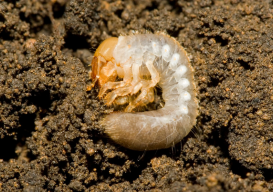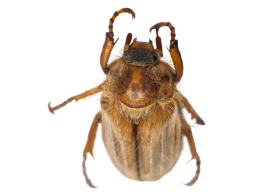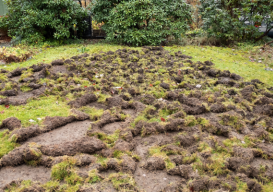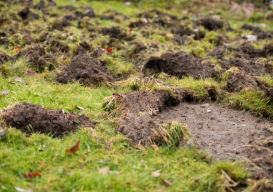European Chafer Beetle
What is a European Chafer Beetle?
The European Chafer Beetle is an invasive insect that has been causing damage to lawns in the Lower Mainland since 2001.
Why is it a problem?
Chafer beetle infestations can be very damaging to lawns, crops and plants. Beetle larvae, or grubs, eat the roots of grass, damaging the grass and creating brown, dying patches on your lawn. The grubs also attract animals like birds, skunks and raccoons who dig up the grass to eat them. Grubs prefer grass, however, if food is scarce they will also eat the roots of crops, including corn, potatoes, berries and the root systems of ornamental and nursery plants.
What do they look like?
Grubs are recognizable by their white C-shaped body and brown heads. Mature chafer grubs are approximately 25mm long when fully grown.

 Chafer larvae (grubs) Adult Chafer
Chafer larvae (grubs) Adult Chafer
How can I tell if my lawn is infested?
The beetles tend to infiltrate the soil in summer to lay their eggs. These eggs hatch into grubs and begin to feed on grass roots, creating brown, dying patches. Animals like birds, skunks and raccoons start smelling the grubs and digging for them in fall and early spring. This is when the most damage occurs.


How can I help prevent them?
- Maintain a healthy lawn: Keep up your turf routine! Aerate, fertilize, and water your lawn to boost resiliency. Please note that the City's summer lawn watering restrictions must be followed from May 1 - October 15.
- Mow your grass longer (6-9cm): This makes it harder for female beetles to lay eggs in the grass, so they will be more likely to move on. Longer grass is also more drought tolerant.
- Try different types of ground cover: Adding even 5% micro-clover, moss, or creeping thyme into your lawn creates heavier root mass, making it harder for grubs to wear away at it. Other lawn substitutes, such as xeriscaping, pollinator gardens, or raised beds also help. Synthetic lawns are not recommended because they are less environmentally-friendly.
- Use barriers: Cover your lawn with cloth or landscape fabric for the duration of the mating and egg-laying cycle (Summer) to prevent beetles from infesting your lawn. You can also use barriers during the spring and fall to limit birds and mammals from eating the grubs.
What can I do if my yard becomes infested?
- Wait for the right time to treat: The best time to treat is from Spring to Fall when the grubs are active and the soil is warm and moist. Winter is not recommended because the treatments become inactive in cold weather.
- What to use: Biological control methods such as microbial larvicides or predatory nematodes (tiny worms) can be purchased at local garden centres and department stores. Before applying these, remove excess thatch and irrigate your lawn. The preferred control method is Bacillus thuringiensis galleriae, or Btg for short, and is a bacteria that kills larvae or beetles when ingested. This option is sold under trade names such as Grub B Gon, GrubGone G, and grubGONE! and can be found in most local garden centres and department stores. Btg is non-chemical and can be applied more than once to ensure successful treatment. It is more cost effective and has a higher success rate than other treatments.
What do I do with the infested soil?
- Don’t remove the soil: Soil from infested areas should not be removed due to the high risk of spread. Instead, rototill and add a layer of soil and grub-resistant grass seed mix in the Spring to improve growing conditions. Over time, natural bacteria and fungus in the soil reduce the number of grubs.
For more information, please refer to the Province's guide on European Chafer Beetles.
| Attachments | |||
| Description | Date | File Size | |
| European Chafer Beetle Brochure - City of Chilliwack | 2025-06-16 | 344.26MB | |
| Provincial guide - European Chafer | 2025-01-13 | 628KB | |
